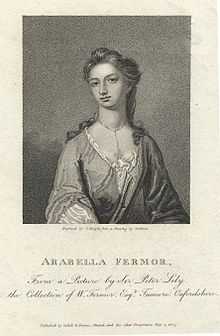The Rape of the Lock

The Rape of the Lock is a mock-heroic narrative poem written by Alexander Pope, first published anonymously in Lintot's Miscellaneous Poems and Translations in May 1712 in two cantos (334 lines), but then revised, expanded and reissued in an edition "Written by Mr. Pope" on 4 March 1714,[1] a 5-canto version (794 lines) accompanied by six engravings. Pope boasted that the poem sold more than three thousand copies in its first four days.[2] The final form of the poem was available in 1717 with the addition of Clarissa's speech on good humour.
Description
The poem satirises a minor incident by comparing it to the epic world of the gods. It was based on an actual incident recounted by Pope's friend, John Caryll. Arabella Fermor and her suitor, Lord Petre, were both from aristocratic recusant Catholic families at a period in England when under such laws as the Test Act, all denominations except Anglicanism suffered legal restrictions and penalties (for example Petre could not take up his place in the House of Lords as a Catholic). Petre, lusting after Arabella, had cut off a lock of her hair without permission, and the consequent argument had created a breach between the two families. Pope, also a Catholic, wrote the poem at the request of friends in an attempt to "comically merge the two." He utilised the character Belinda to represent Arabella and introduced an entire system of "sylphs," or guardian spirits of virgins, a parodised version of the gods and goddesses of conventional epic. Pope derived his sylphs from the 17th-century French Rosicrucian novel Comte de Gabalis.[3]
Pope’s poem uses the traditional high stature of classical epics to emphasise the triviality of the incident. The abduction of Helen of Troy becomes here the theft of a lock of hair; the gods become minute sylphs; the description of Achilles’ shield becomes an excursus on one of Belinda's petticoats. He also uses the epic style of invocations, lamentations, exclamations and similes, and in some cases adds parody to imitation by following the framework of actual speeches in Homer's Iliad. Although the poem is humorous at times, Pope keeps a sense that beauty is fragile, and that the loss of a lock of hair touches Belinda deeply. As his introductory letter makes clear, women in that period were essentially supposed to be decorative rather than rational, and the loss of beauty was a serious matter.

The humour of the poem comes from the storm in a teacup being couched within the elaborate, formal verbal structure of an epic poem. It is a satire on the contemporary society which showcases the lifestyle led by some people of that age. Pope arguably satirises the society by being a part of it rather than standing outside and looking down on the fellow beings. Belinda's legitimate rage is thus alleviated and tempered by her good humour, as directed by the character Clarissa.
Three of Uranus's moons are named after characters from The Rape of the Lock: Belinda, Umbriel, and Ariel, the last name also (previously) appearing in Shakespeare's The Tempest.
It is one of the most commonly cited examples of high burlesque.
Dedicatory letter
Pope added to the second edition the following dedicatory letter:
To Mrs. Arabella FermorMadam,
It will be in vain to deny that I have some regard for this piece, since I dedicate it to You. Yet you may bear me witness, it was intended only to divert a few young Ladies, who have good sense and good humour enough to laugh not only at their sex's little unguarded follies, but at their own. But as it was communicated with the air of a secret, it soon found its way into the world. An imperfect copy having been offered to a Bookseller, you had the good nature for my sake to consent to the publication of one more correct: This I was forced to, before I had executed half my design, for the Machinery was entirely wanting to complete it.
The Machinery, Madam, is a term invented by the Critics, to signify that part which the Deities, Angels, or Dæmons are made to act in a poem: For the ancient poets are in one respect like many modern ladies: let an action be never so trivial in itself, they always make it appear of the utmost importance. These Machines I determined to raise on a very new and odd foundation, the Rosicrucian doctrine of Spirits.
I know how disagreeable it is to make use of hard words before a lady; but 'tis so much the concern of a poet to have his works understood and particularly by your sex, that you must give me leave to explain two or three difficult terms.
The Rosicrucians are the people I must bring you acquainted with. The best account I know of them is in a French book called Le Comte de Gabalis, which both in its title and size is so like a novel, that many of the fair sex have read it for one by mistake. According to these gentlemen, the four elements are inhabited by spirits, which they call Sylphs, Gnomes, Nymphs, and Salamanders. The Gnomes or Dæmons of Earth delight in mischief; but the Sylphs, whose habitation is in the air, are the best-conditioned creatures imaginable. For they say, any mortals may enjoy the most intimate familiarities with these gentle spirits, upon a condition very easy to all true adepts, an inviolate preservation of Chastity.
As to the following Cantos, all the passages of them are as fabulous as the Vision at the beginning or the Transformation at the end; (except the loss of your Hair, which I always mention with reverence). The human persons are as fictitious as the airy ones, and the character of Belinda, as it is now managed, resembles you in nothing but in Beauty.
If this poem had as many graces as there are in your person, or in your mind, yet I could never hope it should pass through the world half so uncensured as you have done. But let its fortune be what it will, mine is happy enough, to have given me this occasion of assuring you that I am, with the truest esteem,
Madam,
Your most obedient, Humble Servant,
A. Pope
Summary
In the beginning of this mock-epic, Pope declares that a "dire offence" (Canto 1 line 1)[4] has been committed. A lord has assaulted a "gentle belle" (line 8), causing her to reject him. He then proceeds to tell the story of this offence.
It begins with Belinda still asleep. Her "guardian Sylph" (line 20), named Ariel, warns her while she sleeps that "some dread event [impends], Ere to the main this morning sun descend; But Heaven reveals not what, or how, or where; Warned by the Sylph, oh pious maid beware!" (line 109–110). Belinda then awakes and proceeds to get ready for the day with the help of her maid, Betty. The Sylphs, though unseen, also contribute. "These set the head, and those divide the hair, some fold the sleeve, whilst others plait the gown" (line 146–147). Belinda appears so beautiful that as she journeys to Hampton Court (canto 3 line 1–10) "every eye was fixed on her alone" (Canto 2 line 6). Here Pope also describes Belinda's two locks of hair "which graceful hung behind" (line 20). The Baron, one of Belinda's suitors, greatly admires these locks and conspires to steal one. He builds an altar and on it places "all the trophies of his former loves" (line 40), sets them on fire, and fervently prays "soon to obtain, and long possess" (line 44) the lock.
Ariel, disturbed by the impending event, though he does not know what it will be, summons many sylphs to him and instructs them to guard Belinda from anything that may befall her, whether she "forget her prayers, or miss a masquerade, Or lost her heart, or necklace, at a ball" (line 108–109). These spirits hover over Belinda, anxious to protect her as she arrives at Hampton Court. Here she is invited to play a game of ombre, which game she wins.
The Baron still conspires to get her lock. He acquires a pair of scissors and tries to snip it off. The Sylphs sent to watch over her, intervene by blowing "back the hair" and twitching "the diamond in her ear" (canto 3 line 136–137), causing Belinda to look around, and stopping the Baron in his plans. This happens three times, but in the end the Baron manages to cut off the lock (also cutting a Sylph in two, but Pope reassures us that "airy substance soon unites again [line 152]). When Belinda discovers her lock is gone, she falls into a tantrum, with "living lightning" flashing in her eyes" (line 155). The Baron celebrates his victory.
A gnome named Umbriel journeys to the Cave of Spleen and from the Queen receives a bag of "sighs, sobs, and passions, and the war of tongues" (canto 4 line 84) and a vial filled "with fainting fears, soft sorrows, melting griefs, and flowing tears" (line 85–86) and brings them to Belinda. He finds her dejected in the arms of the woman Thalestris, and pours the bag and vial over them both. This causes all the emotions from the bag and vial to fill them.
Many people, moved by Belinda's grief over her lock, demand it back, but the Baron is unrepentant and refuses. Clarissa admonishes them to keep their good humour, but they don't listen and "called her prude" (canto 5 line 165), and instead a court battle ensues between the nobles. Their weapons are glares, songs, and wits. Belinda fights with the Baron and throws snuff up his nose to subdue him. She threatens to kill him with a bodkin (a sharp hairpin).[5] She demands that he restore the lock, but they soon discover that it has been completely lost. They search everywhere for it, but cannot find it.
At the end, Pope tells us to "trust the Muse—for she saw it upward rise...A sudden star, it shot through liquid air, and drew behind a radiant trail of hair" (canto 5 line 252–257). Belinda's lock of hair became a star and "this lock the Muse shall consecrate to fame, and 'midst the stars inscribe Belinda's name" (line 280). Even when we are all dead and gone, Belinda's lock of hair shall live on forever.
Editions
- Pope, Alexander. "The Rape of the Lock." The Broadview Anthology of British Literature. Ed. Joseph Black, Leonard Conolly, Kate Flint, Isobel Grundy, Don LePan, Roy Liuzza, Jerome J., Anne Lake Prescott, Barry V. Quallis, Claire Waters. Broadview Press, 2006. 443–456. Print.
References
- ↑ Halsband, Robert. 'The Rape of the Lock' and its illustrations, 1714-1896, Oxford University Press, 1980, p. 1.
- ↑ Sherburn, G., Ed. Correspondence of Alexander Pope, Oxford University Press, 1956, I, 201.
- ↑ Seeber, Edward D. (1944). "Sylphs and Other Elemental Beings in French Literature since Le Comte de Gabalis (1670)". PMLA 59 (1): 71–83.
- ↑ Pope, Alexander. "The Rape of the Lock." The Broadview Anthology of British Literature. Ed. Joseph Black, Leonard Conolly, Kate Flint, Isobel Grundy, Don LePan, Roy Liuzza, Jerome J., Anne Lake Prescott, Barry V. Quallis, Claire Waters. Broadview Press, 2006. 443–456. Print.
- ↑ Broadview Anthology of British Literature. Pg 455, footnote 8
External links
| Wikisource has original text related to this article: |
| Wikimedia Commons has media related to The Rape of the Lock. |
- "The Rape of the Lock:" Study Guide With Complete Text and Detailed Explanatory Notes
- "The Rape of the Lock:" Study Guide,Summary, Selected Quotes, Themes and Detailed Explanatory Notes
- The Rape of the Lock and Other Poems at Project Gutenberg
| |||||||||||||||||||||||||||||
